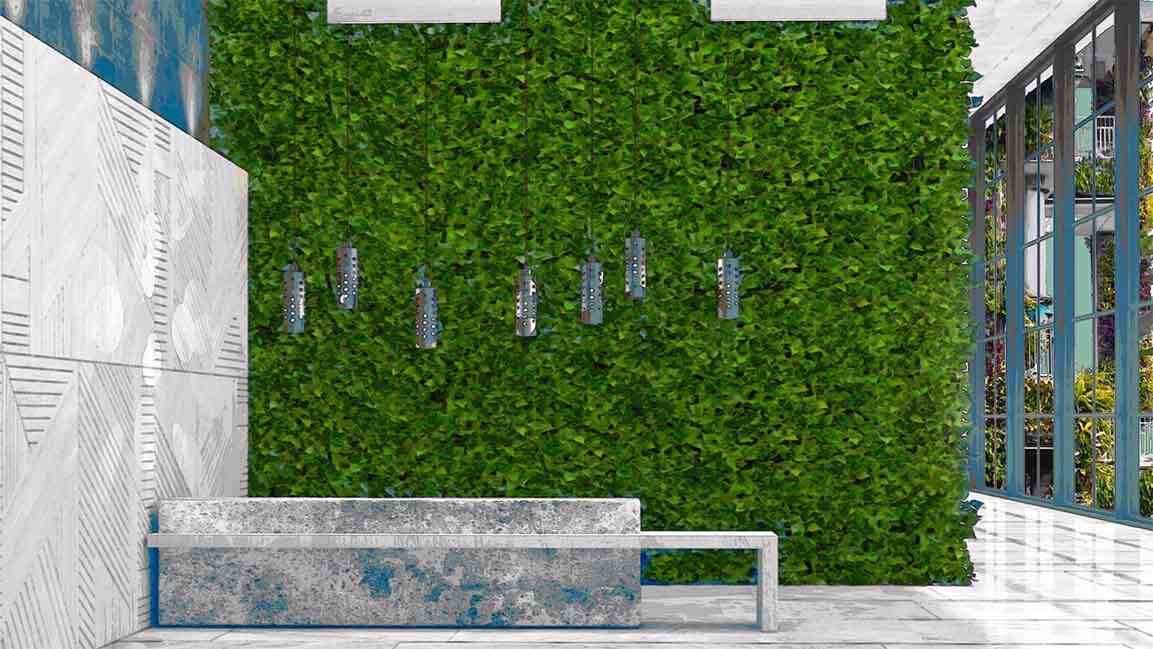- | 9:00 am
These gardens improve air quality, decrease energy consumption, and even shield buildings
As cities in the Middle East continue to grow, vertical gardens provide a way to incorporate green spaces into the urban environment

Many of our modern problems can be solved by a simple remedy: nature. We could incorporate natural elements in our concrete urban jungles and transform those gray settings into green fields. A cityscape can shift to become a verdant vertical forest, where skyscrapers are adorned with walls of greenery.
Perhaps the best design isn’t a rarely skewed structure or one that resembles a basket or some tree branches, but one that protrudes actual plantations and green leaves rather than balconies, canopies, or a giant giraffe!
Gardening in the desert may seem daunting, but with creativity and the right tools, even the harshest climates can become a green oasis.
COOLING EFFECT ON BUILDINGS
Enter the vertical garden.
This innovative gardening method is a towering wall of greenery that offers relief from the scorching sun and dry air while providing a lush green space to unwind and relax. It can improve air quality, decrease energy consumption, and shield buildings from harsh weather.
A study published in the Building and Environment journal has revealed that these living installations can yield substantial energy savings of up to 15% for cooling and 20% for heating in specific climates.
Furthermore, the World Green Infrastructure Network (WGIN) has reported that a green wall spanning 100 square meters has the potential to generate approximately 3,000 kilograms of oxygen annually, thus promoting improved indoor air quality and potentially diminishing the reliance on mechanical ventilation.
In addition, a study published in Sustainable Cities and Society has established that vertical gardens can effectively combat the urban heat island effect, reducing air temperatures in neighboring areas by 2-3°C during the day and as much as 7°C during the night.
These reports draw attention to the promising potential of vertical gardens in cooling in urban buildings, and fostering energy-efficient urban environments.
But, one needs to choose their plant species wisely, opting for hardy, drought-resistant varieties that can withstand the heat. An efficient irrigation system will also keep the plants from withering under the scorching sun.
“Designing and building vertical gardens is not a new concept. It may be uncommon for most of the developments in this region because of the concern of sustaining the livability of the plants all year round, but it is possible nonetheless. The use of native flora from the Arabian Peninsula, especially the ones found in the desert, would be interesting to study. Green poles that use native plants could be installed in areas where trees cannot grow,” said Nino Ricardo, a Dubai-based architect and landscape design specialist.
SOLUTION TO URBANIZATION
Vertical gardens are a solution to urbanization. As cities in the Middle East continue to grow, vertical gardens provide a way to incorporate green spaces into the urban environment without taking much of the needed horizontal space. Dubai and Abu Dhabi are embracing vertical farms and integrating them into their urban landscape. The city’s green initiatives aim to create more green spaces and improve air quality, making vertical gardens a vital part of its sustainability efforts.
“Cities with vertical gardens are more alive than others. We usually call them living walls, where everything is covered with greenery, and you can feel the life around the buildings. Hopefully, the cities will be filled with more living walls in the future,” said Tala Aridi, a Dubai-based landscape architect.
The benefits of vertical gardening are various. They add vibrant greenery, improve air quality, provide insulation, and reduce energy costs. However, vertical gardens have their challenges. For example, watering and maintenance can be tricky, and the plants must be carefully selected to ensure they can thrive in the vertical environment.
“The maintenance challenge exists due to the extreme weather conditions and the irrigation demand. I question if the green walls will still look beautiful throughout the year. Nevertheless, vertical gardens soften the building façade,” said Paweena Sriwichit, a Dubai-based senior landscape architect.
Despite the challenges, the Middle East is embracing vertical gardening. The Green Wall of Dubai, a vertical garden located in the heart of the city, is one of the largest in the world, covering an area of 8,000 square meters. It is part of the Dubai Miracle Garden, a stunning floral garden.
Another example of a vertical garden can be found at the King Abdul-Aziz Center for World Culture in Dhahran, comprising over 20,000 plants and flowers, including a variety of local species. It is a great example of how green spaces can be integrated into modern architecture to create a more sustainable and livable environment.
The Vertical Oasis in Doha is another project that combines sustainable architecture, urban farming, and green spaces. The project uses hydroponic technology to grow plants vertically, creating a sustainable urban farm in the city’s heart.
Vertical gardens are transforming the urban landscape of the Middle East, providing a much-needed connection to nature. They can shape the future of sustainable cities in the region.
Vertical gardens have the potential to transform the region’s architecture and design, adding a new dimension of creativity and innovation to the built environment. These green walls offer a canvas for designers to blend the beauty of nature with the sophistication of modern urban design.





































